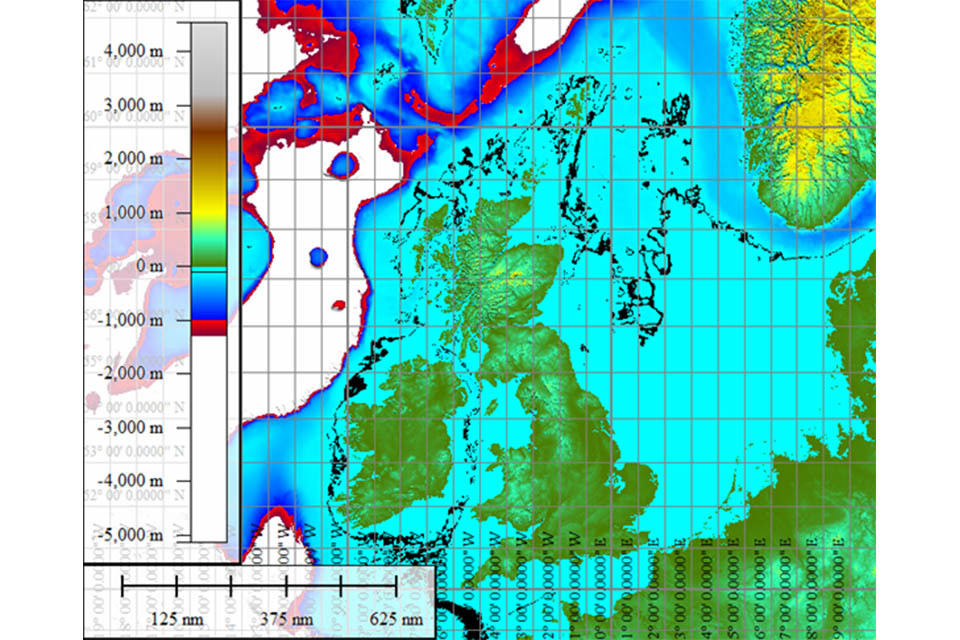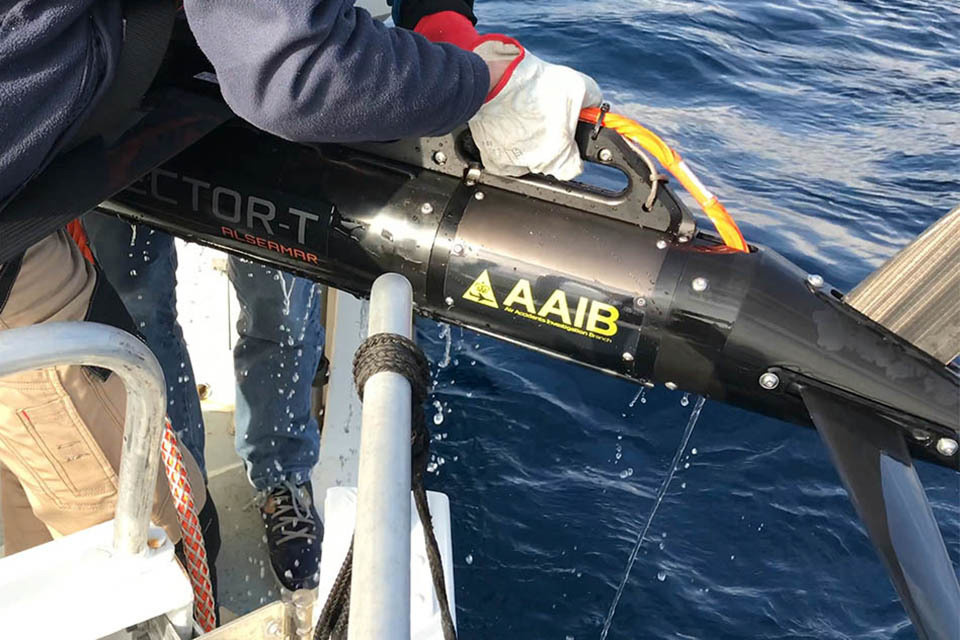Getting to the bottom of aircraft accidents
Published 7 June 2018
An aircraft wreckage and its flight data and cockpit voice recorders often provide vital clues to help us piece together the jigsaw of an accident, but if nobody witnesses an aircraft going missing in water, how do we find it?
The Air Accidents Investigation Branch has replaced its 30-year-old flight recorder (‘black box’) underwater search equipment with new technology capable of locating ‘lost’ aircraft up to 1 km below sea level. This gives us search coverage for all UK waters.

Depth of water surrounding UK with 100-metre contour highlighted in black [Source: The General Bathymetric Chart of the Oceans (GEBCO), One Minute Grid, version 2.0, (http://www.gebco.net)].
Affectionately known as the towfish (a technical term for systems that are towed behind a vessel and ‘fly’ beneath the surface) this is no ordinary piece of equipment. It is just one of a handful of towed systems designed specifically for the acoustic detection of the underwater locator beacon (ULB) attached to all black boxes. It is the only towed ULB detection system designed specifically for shallower continental shelf waters rather than the much deeper open ocean, and complements the more widely used hand-held ULB detectors (that become difficult to use in anything but calm conditions and for extended periods of time).
Extensive search areas
With enhanced information about an aircraft’s whereabouts during flight, introduced following the crash of Air France flight 447 (AF447) in 2009 and the disappearance of Malaysia Airlines flight 370 (MH370) in 2014, our ability to limit the size of the search area has been greatly improved. However, search areas extending to hundreds of square kilometres are still a possibility. Since the 1970s, ULBs have been attached to flight recorders carried by commercial air transport aircraft. On contact with water, the beacons ‘ping’ a short pulse of 37.5 kHz acoustic energy every second for at least 90 days (this was increased from 30 days following AF447). This frequency is limited in range to about 3-4 km and therefore a challenge to detect in very deep water.

The towfish being recovered from the water during sea trials.
As the tow vessel on the surface moves along predetermined tracks that cover the search area, the towfish detects all acoustic sounds in the frequency ranges of interest and sends these, along with temperature and depth information, to the tow vessel where it is recorded and processed. If a ULB is detected, the level of the ‘ping’ increases the nearer the towfish is to the ULB so if a peak in the level is detected we know that the towfish has just gone past the ULB. Turns to the left or right then allow the location of the ULB to be more precisely defined and provide a smaller search area for divers or ROVs (Remotely Operated Vehicles), depending on water depth, to home in on the ULB signal to locate the black boxes and wreckage. Once the black boxes have been recovered from the water, they are taken to the AAIB’s flight recorder laboratories where they are assessed for damage, dismantled and dried, before being downloaded. This data recovery process may take days to complete depending on the level of damage. If we can access the data, it helps us to find out what happened and why, which can be used to improve flight safety and hopefully provides some comfort to the bereaved.
International improvements for more successful sea search
Since the early 1970s, when aircraft were first mandated to fit ULBs to flight recorders, about 40 commercial aircraft have been lost at sea, and in most cases both flight recorders were recovered. Accidents such as AF447 and MH370, however, have highlighted some of the key issues and challenges when trying to locate aircraft lost at sea, and prompted changes in the regulations. As well as increasing the duration of the 37.5 kHz ULB to 90 days, AF447 prompted the specification for an 8.8 kHz ULB to be created offering a much greater detectable range, that is easily detectable from the surface. These are now on aircraft alongside other technologies, such as aircraft flight tracking, that should increase the chances of a successful search and recovery of the flight recorders and possibly wreckage.

AF447 FDR found at about 3,900 m depth [Reproduced by permission. Image copyright BEA/ECPAD. All rights reserved]

